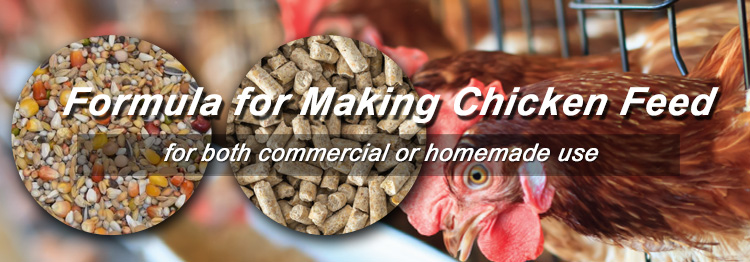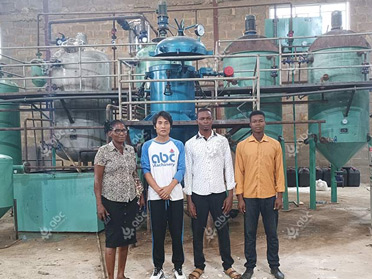Importances of Chicken Feed Formula
As it’s known to us, the cost of poultry feed takes up to 65-75% of the total cost of poultry production business. Therefore, it is really important to have the right formula for chickens. Sometimes, one little mistake on poultry formula will increase production cost or cause great loss for poultry producers or poultry farming business. Chicken feed formulation is to meet the nutritional requirements of the chickens by giving the feed through an optimal combination of different chicken feed ingredients. At the same time, as human society is an economic society, it is not enough to ensure that chickens can grow properly, but they also need to achieve many other requirements, such as growing faster, spending less and earning more. In addition to the animal's own growth and development, reproduction and other needs for energy and protein, there are also human requirements for them, such as the requirement for tender chicken meat, so that humans must artificially change the animal's nutritional needs to achieve certain purposes.

Best Formula to Make Your Own Chicken Feed
Before making poultry feed or setting up feed mill plant for poultry, it is needed to have a full understanding of chicken feed formula:
- Nutrient requirements of different poultry, like laying hens, broilers or breeders.
- Feed composition in terms of nutrient content and nutritional and processing limitations
- Cost and availability of chicken ingredients
Formula for Making Your Own Chicken Feed
A scientific and reasonable chicken feed formula not only makes chickens grow well, effectively improves their strength and promotes their survival rate. At the same time, the standardisation of chicken feed formula can better save the cost of chickens farming, and the compound probiotics significantly improve immunity and stress resistance, prevent persistent diarrhoea, gastroenteritis, cluster enteritis and intestinal infections, and reduce mortality. (Read more: Chicken Feed Manufacturers in Uganda >>)
Feed Formula for Layer
- Formula 1: Bran 3.2%, maize 62%, soybean meal 31%, calcium hydrogen phosphate 1.3%, rock flour 1.2%, additives 1%, salt 0.3%.
- Formula 2: Soya bean meal 24%, maize 61.7%, wheat bran 4.5%, vegetable meal 4%, rock meal 1.2%, fish meal 2%, salt 0.3%, calcium hydrogen phosphate 1.3%, additives 1%.
- Formula 3: a) Corn 62.7%, bran 4%, soybean meal 25%, fish meal 1.5%, vegetable meal 3%, stone meal 1.2%, calcium hydrogen phosphate 1.3%, salt 0.3%, additives 1%.
- b) Note that the additives should contain amino acids, vitamins, growth promoters and trace elements.
Feed Formula for Broiler

- Formula 1: Soya bean meal 38%, stone meal 1%, maize 55.3%, cooking oil 3%, salt 0.3%, additives 1%, calcium hydrogen phosphate 1.4%.
- Formula 2: Corn 54.2%, soybean meal 34%, salt 0.3%, rock flour 1%, cooking oil 3%, vegetable meal 5%, additives 1%, calcium hydrogen phosphate 1.5%.
- Formula 3: Vegetable meal 4%, soybean meal 32%, rock meal 1%, corn 55.2%, calcium hydrogen phosphate 1.5%, fish meal 2%, cooking oil 3%, additives 1%, salt 0.3%
If you are interested in knowing more about animal feed formula or chicken feed formula to start your own poultry feed production business or want to know more about how to make poultry feed, just send your inquiry instantly. ABC Machinery is a professional animal feed processing machine manufacturer and we have helped our customers to set up small scale or commercial scale feed mill plant in different countries, like Nigeria, South Africa, Kenya, Australia, Kuwait, Pakistan, Philippines, Dubai, Mali, Australia, Uzbekistan, Russia, Fiji, Latvia, etc. We have practical experiences in poultry feed production, including poultry feed formula. Welcome to contact us for more details!

Factory Price Chicken Feed Making Machines
Keys for Chicken Feed Making
- Raw Material Selection
Raw material selection gives priority to local feed crops, such as wheat, rice and maize, and then the purchase of additives, premix raw material concentrates, etc., as appropriate. Even if they are reliable raw materials, attention should be paid to their use ratio, just as wheat cannot be used in its entirety to replace energy raw materials, and vegetable meal cannot replace animal-derived protein.
- Absorption Rate of Raw Materials
Chicken farmers often make mistakes when formulating feeds based on relevant information, without paying attention to the absorbability of feed ingredients. For example, in protein feed, the absorption rate of rapeseed meal, soybean meal, fish meal and cotton meal gradually decrease. Some feeds with high protein content sell for less than feeds with low protein content. However, the imbalance of phosphorus and calcium in the ratio of added mineral elements can cause blood and diseased bone disease. For example, 2/3 of the calcium is absorbed in baker's and mussel shells and 1/3 in lime in chicken meat.

 Build Your Future!
Build Your Future!








